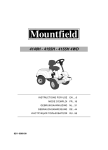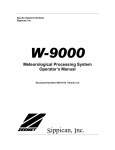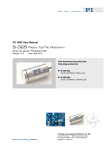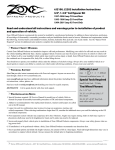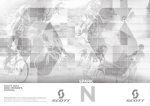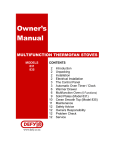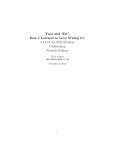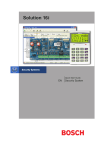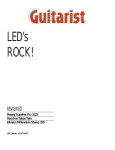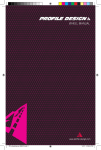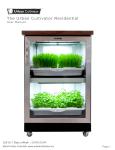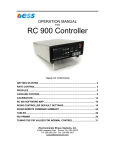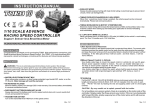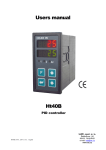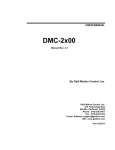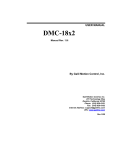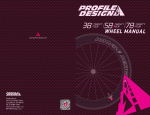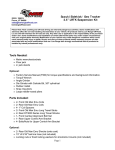Download 262 MK1 - Shopify
Transcript
262 MK1 TABLE OF CONTENTS LIST OF FIGURES AND TABLES .................................................................. 2 INTRODUCTION & ACKNOWLEDGEMENTS.............................................. 4 TERMS AND CONDITIONS OF SALE ........................................................... 5 SPECIFICATIONS ........................................................................................ 7 GENERAL SCHEMATICS ............................................................................. 8 DESIGN INFORMATION ............................................................................ 9 Maximum Rated Load ........................................................................... 9 Axial Loading & Off-Axis Loading ...................................................... 10 Tie-Rod Angle using Vertical and Longitudinal Offsets ................... 10 Axial Loading using Tie-Rod Angle and Forces ................................ 11 Off-Axis Loading using Tie-Rod angle and forces ............................ 11 Rack Speed and Travel ........................................................................ 11 Rack Travel per Degree of Steering Wheel Input ............................ 12 Bump Stops ..................................................................................... 12 Clevis Connection to Tie-Rods ............................................................ 13 ASSEMBLY DIAGRAM ............................................................................. 15 INSTALLATION & OPERATION ................................................................ 17 Mounting Blocks.................................................................................. 17 Hardware ............................................................................................ 17 Lubrication .......................................................................................... 18 Input Shaft Integration........................................................................ 18 Additional Notes.................................................................................. 19 ACCESSORY DRAWINGS ......................................................................... 21 1 LIST OF FIGURES AND TABLES Table 1: Specifications ....................................................................................................... 7 Table 2: Bump Stop Characteristics ................................................................................. 12 Table 3: Parts List ............................................................................................................. 15 Figure 1: Overall Dimensions ............................................................................................. 8 Figure 2: Installation .......................................................................................................... 9 Figure 3: Recommended Tie-Rod Connection to Clevis, Full Size Bolt (Section) .............. 14 Figure 4: Recommended Tie-Rod Connection to Clevis, Undersized Bolt (Section) ........ 14 Figure 5: zRack 262 Assembly View ................................................................................. 15 Figure 6: Housing Retaining Screws ................................................................................. 16 Figure 7: Safety Wire ....................................................................................................... 18 Figure 9: Bump Stops ....................................................................................................... 21 Figure 10: Upper Mounting Block .................................................................................... 22 Figure 11: Lower Mounting Block .................................................................................... 22 2 LIST OF SYMBOLS AND ACRONYMS RS Rack Speed – Linear travel per degree of wheel input LtL Lock to Lock – Distance rack travels from full left to full right. CtC Center to Center – The distance between two axes. OAL Off-Axis-Loading – Any force not parallel to the rack axis TRL Tie-Rod Length SRack Rack Displacement from Center β Steering Wheel Angle from Center FTR Tie-Rod Load Fx Rack Off-Axis Load Component Fy Rack Axial Load Component 3 INTRODUCTION & ACKNOWLEDGEMENTS Thank you and congratulations on your decision to include zRack technology in your vehicle project. This product has been engineered to meet the strictest class requirements for its size and as such should serve its purpose well for many seasons to come. In order to obtain the best possible performance and longevity from your zRack please consider and implement the guidelines and recommendations presented in this document carefully. zRack was envisioned and created by a small group of dedicated engineers with extensive FSAE histories and experiences. From the onset, it has always been apparent to us that many of the products which small race teams use are not particularly suited towards their requirements, but rather are simply all that is available. We hope that by filling this special niche the issue will never again be a matter of compromise, and we will do our utmost to keep the product on the cutting edge of technology and optimization. In addition to an advanced product, we offer our combined experience and expertise in the field of steering and vehicle dynamics and kinematics to assist individuals and teams execute the installation and utilization of it with a focus on safety and integrity. Should you have any questions or concerns about the product which are not explicitly or satisfactorily addressed in this document please do not hesitate to contact us immediately. We would also like to acknowledge and thank the many individuals who have contributed their valuable feedback and experience with the product, and also those teams who showed the interest and trust in us to implement and test the product in its early stages. We welcome any and all feedback which is available, so if you have any comments about your experience or opinions of the product please share them with us, your feedback is greatly appreciated! Thank you again, and we wish you all success in your driving endeavors! Sincerely, The zRack Team 4 TERMS AND CONDITIONS OF SALE OPENING THIS PACKAGE INDICATES YOUR AGREEMENT TO BE BOUND BY THE FOLLOWING TERMS AND CONDITIONS OF SALE SHOULD YOU NOT AGREE WITH ANY PORTION OF THIS AGREEMENT, RETURN THE PRODUCT UNUSED IN ITS ORIGINAL PACKAGING ACCORDING TO INSTRUCTIONS IN SECTION 7 1. Orders. All orders are subject to final acceptance by ZEDARO at its principal place of business in Ontario, Canada. ZEDARO reserves the right to cancel any uncompleted order or to suspend delivery in the event Buyer (1) becomes insolvent, files for or is the subject of any bankruptcy action, or has a receiver appointed for it; or (2) breaches any term of this agreement 2. Delivery and Title. Unless otherwise noted, all goods shall be delivered F.O.B. ZEDARO’s Ontario offices and risk of loss or damage shall pass to Buyer upon ZEDARO’s delivery of goods to shipper or carrier for delivery. Buyer is responsible for all shipping, handling and insurance charges. Unless Buyer specifically requests a method of shipment, ZEDARO shall exercise its reasonable discretion in selecting a carrier. If Buyer requests delivery via an insured and express courier such as Federal Express, Airborne or DHL, where possible, Buyer can provide ZEDARO with its account number with such courier to facilitate shipment. Times quoted for shipment will be from the date of order confirmation to Buyer. Unless the parties specifically agree to the contrary, time will not be deemed of the essence in the transaction. 3. Taxes. All applicable taxes, levies or duties (of whatever nature) will be paid by Buyer, or in lieu thereof, the Buyer shall provide ZEDARO with a tax exemption certificate acceptable to the taxing authorities. 4. Payments. Each shipment shall be considered a separate transaction and payment shall be made accordingly. In the event of default by Buyer, ZEDARO may decline to make further shipments without in any way affecting its rights under other orders. Should ZEDARO decide to continue to make shipments despite any default by Buyer, its action shall not constitute a waiver of such default or in any way offset or limit ZEDARO’s legal remedies for such default. 5. Limited Warranty. A. ZEDARO warrants the following with respect to Product manufactured by ZEDARO or bearing the ZEDARO label: (1) that the Product is free from defects in material and workmanship and when used in accordance with the user manual supplied with the Product, will operate substantially in accordance with the applicable functional specifications applicable to the product purchased; and (2) that upon payment in full for the Product, they shall be rendered free and clear of liens, claims or encumbrances. B. The above Product warranty shall extend to the original end user purchaser of the Product for a period of twelve (12) months from the date of shipment. With respect to any products sold but not manufactured by ZEDARO or bearing the ZEDARO label, ZEDARO will assign to Customer all available manufacturer warranties. The warranty period for repaired or replaced Products shall be the remainder of the original warranty period for the repaired or replaced item. C. ZEDARO's sole liability under this warranty shall be (a) either to repair or to replace, at ZEDARO’s option, the defective Product component(s) in accordance with ZEDARO’s return and repair procedures, or (b) if after repeated efforts ZEDARO is unable to resolve the defect by repair or replacement, to refund the purchase price upon return of the defective item. ZEDARO shall incur no obligation under this warranty if (1) the allegedly defective Product is returned to ZEDARO more than thirty (30) days after the expiration of the applicable warranty period; (2) if ZEDARO’s verifiable tests disclose that the alleged defect is not due to defects in material or workmanship; or (3) if, in ZEDARO’s sole judgment, the Product has been subjected to misuse or neglect, alteration, improper maintenance or damage due to excessive physical or heat or stress. This Product warranty is void if the serial number of the Product has been defaced, altered or removed. 5 6. Warranty Limitations and Exclusions. A. THE WARRANTIES SET FORTH ABOVE FOR THE PRODUCTS PROVIDED HEREUNDER ARE COMPLETE AND ARE IN LIEU OF, AND CUSTOMER HEREBY WAIVES, ALL OTHER CONDITIONS, REPRESENTATIONS, AND WARRANTIES, EXPRESS OR IMPLIED BY STATUTE, USAGE, CUSTOM OF THE TRADE OR OTHERWISE, INCLUDING WITHOUT LIMITATION, THE IMPLIED WARRANTIES OF MERCHANTABILITY AND FITNESS FOR A PARTICULAR PURPOSE. NOTWITHSTANDING ANY OTHER OR PRIOR STATEMENT, WRITTEN OR ORAL, ZEDARO MAKES NO OTHER WARRANTIES REGARDING THE QUALITY OF ITS PRODUCT(S) OR THE MATERIALS COMTEMPLATED HEREUNDER AND ZEDARO EXPRESSLY DISCLAIMS ANY WARRANTIES OF DURABILITY, THAT THE PRODUCT WILL MEET ALL OF CUSTOMER’S NEEDS OR THAT THE OPERATION OF THE PRODUCTS WILL BE ERROR FREE. B. Customer acknowledges and agrees that the Products supplied under this Agreement are intended for test purposes within the confines of the Formula SAE competition, and are not specifically designed, manufactured or intended for use or resale in critical applications or hazardous environments requiring fail-safe performance and in which the failure of Products could lead directly to death, personal injury, or severe physical or environmental damage (“High Risk Activities”). ZEDARO and its suppliers explicitly disclaim any express or implied warranty of fitness for any such use and the customer hereby agrees to release and hold ZEDARO harmless from liability resulting out of or in connection with implementation of these Products in High Risk Activities. C. LIMITATION OF LIABILITY. ZEDARO’S LIABILITY SHALL BE LIMITED TO THE PRICE PAID BY CUSTOMER FOR THE GOODS OR TO REPLACEMENT OF THE GOODS, AND CUSOMTER SHALL BE ENTITLTED TO NO OTHER REMEDY, REGARDLESS OF THE FORM OF THE CLAIM. ZEDARO SHALL NOT BE LIABLE FOR INDIRECT, SPECIAL, INCIDENTAL, CONSEQUENTIAL OR PUNITIVE DAMAGES ARISING FROM OR RELATING TO THE USE OF OR INABILITY TO USE THE PRODUCT, WHETHER OR NOT SUCH DAMAGES ARE FORESEEABLE AND WHETHER OR NOT CUSTOMER HAS BEEN ADVISED OF THE POSSIBILITY OF SUCH DAMAGES, INCLUDING BUT NOT LIMITED TO LOST PROFITS OR REVENUE, ATTORNEYS' FEES, DAMAGE TO BUSINESS, LOSS OF USE OF EQUIPMENT, DOWN-TIME COSTS OR DAMAGES FOR DELAY, OR FOR DAMAGES FOR ECONOMIC LOSSES OR PROPERTY DAMAGE ARISING FROM ANY ACTS OR OMISSIONS, WHETHER IN NEGLIGENCE, STRICT LIABILITY, OR OTHER PRODUCT LIABILITY THEORIES. THE LIMITATIONS OF LIABILITY AND WARRANTY DISCLAIMERS STATED IN THIS AGREEMENT FORM AN ESSENTIAL BASIS OF THE BARGAIN BETWEEN THE PARTIES AND APPLY REGARDLESS OF WHETHER ANY LIMITED REMEDY HEREUNDER FAILS OF ITS ESSENTIAL PURPOSE. 7. Product Repair and Return Procedures. No Product shall be returned without prior authorization from ZEDARO. Inoperative or malfunctioning Product must be returned by Customer in protective material, securely packaged to prevent damage in transit with the original proof of purchase, and shipped prepaid to: ZEDARO, 120 Otonabee Drive, Kitchener, ON, N2C 1L6, Canada - Phone: (519) 725-2554 ZEDARO will return repaired/replaced Product via surface freight to Customer’s location. The cost of expedited freight, if requested, shall be at Customer's expense. Product found to be operable after testing (i.e. no trouble found), may be subject to ZEDARO's then-current handling charge. Repairable out-of-warranty Product will be repaired at ZEDARO’s then-current repair charges upon receipt of the Product and Customer's applicable purchase order or other written authorization to repair. 8. Entire Agreement; Assignment. This constitutes the entire agreement of the parties and supersedes all prior written or oral agreements, representations or understandings relating to the subject matter hereof. Buyer will not assign its order or any interest therein or any rights under this agreement without the prior written consent of ZEDARO. 9. Force Majeure. Neither party shall be liable for any failure or delay in performance of its obligations under this agreement where such performance is prevented or delayed by causes beyond its reasonable control, including without limitation, flood, war, embargo, strike or other labor dispute, riot, acts of God or the intervention of any government authority. 10. Governing Law; Disputes. The rights and obligations of the parties arising under or in connection with the sale of ZEDARO product shall be governed by the laws of the Province of Ontario, Canada. In the event of a dispute relating to ZEDARO product, it is agreed that the parties shall first submit their dispute to mediation pursuant of the Commercial Mediation Rules of the Canadian Arbitration Association to be held in Ontario, Canada within 30 days from receipt of written notice of a claim or dispute. The parties shall make a good faith attempt to resolve their dispute through mediation before seeking any other legal remedy. A party’s failure to respond to a request for mediation or to attend a scheduled mediation shall entitle the other party to seek other legal relief. 6 SPECIFICATIONS Property Mass – Assembly Only Mass – Installed, w/Mounts 0.235 kg 0.273 kg zRack 262 0.52 lb 0.60 lb Kinematic Length Linear Travel Per Degree of Steering Input 262 mm 0.2383 mm 10.315 in 0.00938 in Max Linear Travel Per Side Max Rotary Input Per Side 25.1 mm 105.4° 0.988 in Recommended Lin. Travel Per Side Recommended Rotary Input Per Side ≤ 25.0 mm ≤ 104.9° ≤ 0.984 in Max Axial Load Rating Max Off-Axis Load Rating (Per Side) Max Steering Torque 6670 N 2280 N 91 Nm 1500 lbf 512 lbf 67 lbf-ft Recommended Max Axial Load Recommended Max Off-Axis Load (Per Side) Recommended Max Steering Torque 1780 N 780 N 24 Nm 400 lbf 175 lbf 18 lbf-ft Max Allowable Tie Rod Angle Recommended Tie Rod Angle 10° 0±5° CG Vertical Location from Rack Axis CG Lateral Displacement Range 5.950mm (Towards Pinion Axis) 0±11.633mm Static Friction / Stiction Range Static Friction Torque Range 8N ± 1N 0.2 Nm± 0.03Nm Input Shaft Material / Hardness AISI 4140H / 34 RC Pitch Mass Moment of Inertia @ CG1 Yaw Mass Moment of Inertia @CG1 Roll Mass Moment of Inertia @CG1 47615 gmm2 1112699 gmm2 1020306 gmm2 Tie-Rod Clevis Cross Drill Diameter 6.363 ± 0.013 mm 0.2505 ± 0.0005 in Table 1: Specifications [1] Note: Mass moments of inertia indicated assuming pinion axis is horizontal, with rack parallel to vehicle pitch axis and ground plane. 7 GENERAL SCHEMATICS This section outlines the main design geometry which is required for design integration purposes. Figure 1: Overall Dimensions 8 DESIGN INFORMATION This section is intended to provide information pertaining to the preferred installation and design integration procedures. It is very important that these recommendations are heeded in order to ensure the safe and reliable operation of the product. All mounting block bolts are M6x1, Class 12.9, DIN 912 Figure 2: Installation Maximum Rated Load The maximum rated load is the full axial force in tension or compression which the rack is designed to withstand in service. Under normal driving conditions this load is not typically experienced except in cases of collision involving the front wheels. The maximum rated load has been designated as the maximum load that any person could be expected to hold keeping the steering wheel still. In reality, the typical driver posture and position make it nearly impossible to exert the maximum load on the steering system. Furthermore, it is of critical importance for the sake of safety that drivers be instructed and trained to release their grip from the steering wheel in cases of imminent collision in order to reduce the risk of serious injury. For the purposes of load matching the maximum rated load (6670 N) can be used to design related steering components. Alternately, a more aggressive load rating can be used which better matches actual driving conditions excluding impact events. In this case it is recommended to use a load of 1780 N. Please note that components which are not rated to withstand impact events must also be designed in such a way as to not endanger the safety of the driver in any mode of failure. Maximum Rated Axial Load Recommended Design Axial Load 9 = 6670 N = 1780 N (1,500 lbf) (400 lbf) Axial Loading & Off-Axis Loading Differentiation exists between the recommended axial load and off-axis load. Please consider and understand the following definitions: Axial Loading: A force which acts parallel to and along the cylindrical axis of the rack. Off-Axis Loading (OAL): Any components of the loads applied to the rack not parallel to the rack axis. In order to determine the OAL the tie-rod load is separated into two components based on the angle between the tie-rod and rack axis. Note that the methods below assume that the rack axis is perpendicular to the vehicle longitudinal centerline and parallel to the ground plane. The loading on the rack must also be considered as the net sum of the two tie-rod loads. Consider that the maximum pinion tooth loading occurs when tie-rod forces are acting in the same direction, whereas significant axial rack loading still occurs when they are acting in opposite directions (such as under hard braking). It is also recommended to operate the rack under the minimum possible off-axis conditions; as off-axis loading has detrimental effects to the rack and pinion tooth mesh, rack bearing loads and friction, and out-of-plane mounting bulkhead loading. In extreme cases, off-axis loading will result in decreased service life, increased steering effort requirements, and a larger overall turning circle radius than what might otherwise be possible. The calculations presented here are simplified and for reference only. It is recommended that final design calculations be based on vector representations for all forces and moments and be conducted throughout the full spectrum of the suspension and steering travel under all driving conditions. Tie-Rod Angle using Vertical and Longitudinal Offsets Point 1: Steering Clevis Node Point 2: Steering Arm Node Tie-Rod Length: Vertical Offset : Longitudinal Offset: (X1, Y1, Z1) (X2, Y2, Z2) TRL ∆Z = Z2 – Z1 ∆X = X2 – X1 Tie-Rod Angle 𝛼 = sin−1 ( √∆𝑋 2 + ∆𝑍2 𝑇𝑅𝐿 ) *Note that it is recommended to work in degrees! THE MAXIMUM ALLOWABLE TIE-ROD ANGLE IS 10°… 0±5° IS RECOMMENDED. 10 Axial Loading using Tie-Rod Angle and Forces Right Tie-Rod Force Tie-Rod Angle Rack Axial Load (Right) FTR1 (Positive when acting from left to right) FTR2 (Positive when acting from left to right) 𝛼 𝐹𝑦1 = 𝐹𝑇𝑅1 cos(𝛼) Rack Axial Load (Left) 𝐹𝑦2 = 𝐹𝑇𝑅2 cos(𝛼) Net Axial (Tooth Mesh) Load 𝐹𝑦𝑁𝑒𝑡 = 𝐹𝑦1 + 𝐹𝑦2 Net Steering Wheel Torque 𝑇𝑁𝑒𝑡 = 𝐹𝑦𝑁𝑒𝑡 × (13.608 𝑚𝑚) Left Tie-Rod Force THE MAXIMUM ALLOWABLE NET AXIAL TOOTH MESH LOAD IS 6670 N MAX INPUT TORQUE IS 91 Nm. Off-Axis Loading using Tie-Rod angle and forces Right Tie-Rod Force FTR1 (Positive when acting from left to right) FTR2 (Positive when acting from left to right) 𝛼1 𝛼2 𝐹𝑥1 = 𝐹𝑇𝑅1 sin(𝛼1 ) 𝐹𝑥2 = 𝐹𝑇𝑅2 sin(𝛼2 ) Left Tie-Rod Force Right Tie-Rod Angle Right Tie-Rod Angle Off-Axis Load (Right) Off-Axis Load (Left) Net off-axis loading and moments must be calculated with vector force representation. THE MAXIMUM ALLOWABLE OFF-AXIS LOAD PER SIDE IN ANY DIRECTION IS 2280 N. Rack Speed and Travel The linear travel of the rack is constant and proportional to the rotary steering input angle. The ratio has been chosen based on extensive experience to be compatible with competitive entries in the Formula SAE / STUDENT classes. The term ‘Rack Speed’ is commonly used to compare the ratio of rack linear travel per full turn of the steering wheel (360°). RACK SPEED = 85.8 mm / Revolution, Constant. 11 Rack Travel per Degree of Steering Wheel Input Steering Input Angle β (-105.4° ≤ β ≤ 105.4°) Rack Position 𝑆𝑅𝑎𝑐𝑘 = β × 360° (-25.1 mm ≤ 𝑆𝑅𝑎𝑐𝑘 ≤ 25.1 mm) 85.8 𝑚𝑚 Note that when the rack is moved to the limit on either side, there is mechanical contact between the rack and the housing to limit travel and protect the pinion teeth. Consider that such contact will inevitably cause some wear to the rack and housing. If possible it is recommended to use a slightly lower travel for design (i.e. ≤ 25 mm) Bump Stops Bump stops with some elastic / damping properties should be manufactured and installed to limit rack travel to within the allowable range defined by the steering kinematic design. The hygroscopic expansion/contraction properties of any polymers used for bump stops must be accounted for to ensure that adequate travel and clearances can be maintained in service. RECOMMENDED: Urethane, Silicone, PEEK NOT RECOMMENDED: Nylon, ABS, Delrin/Acetal, Metals In order to streamline the design of bump stops for specific applications, the following table is presented, intended to provide basic dimensions for various travel requirements assuming a rigid bumpstop material. Note that these values are for reference only. Lock to Lock Angle Total Travel Travel per Side Bump Stop Thickness 170° 180° 210° mm 40.375 in 1.5896 mm 42.750 in 1.6831 mm 49.875 in 1.9636 20.188 0.7948 21.375 0.8415 24.938 0.9818 5.020 0.1980 3.833 0.1509 0.270 0.0106 Table 2: Bump Stop Characteristics * Please see Figure 9 in section “ACCESSORY DRAWINGS” for dimensional data. 12 Clevis Connection to Tie-Rods Tie-rod clevises which are compatible with standard spherical rod end connectors ranging in size M4-M6 (#8-¼ in) from have been supplied. The clevis pin bore diameter is 6.35mm (0.25 in), and in cases where smaller diameter pins or bolts are desired it is necessary to manufacture spacers with stepped bosses to account for the difference in size. Spacers which have stepped bosses should be designed such that the top of the boss does not extend beyond the outer faces of the clevis; otherwise the clamping force of the clevis bolt will not be applied equally to the clevis and spacer/rod-end stack. Boss tolerances should create a transitional fit (H9/n6). Use high quality fasteners to make the connection between the tie-rod spherical ball joints and the clevises. It is recommended to use partially threaded fasteners which are not threaded in the shear zones between the clevis forks, spacers, and the tie-rod ball. 13 RECOMMENDED TIE-ROD CONNECTION BOLTS: AN4-10A Figure 3: Recommended Tie-Rod Connection to Clevis, Full Size Bolt (Section) Figure 4: Recommended Tie-Rod Connection to Clevis, Undersized Bolt (Section) 14 ASSEMBLY DIAGRAM Figure 5: zRack 262 Assembly View Table 3: Parts List 1 - Front Housing 2 - Rear Housing 3 - Rack 4 - Pinion 5 - Input Shaft 6 - Clevis (2) 7 - 153 End Collet (2) 8 - Scraper (2) 9 - Wear Ring (2) 10 - Pinion Bearing (2) 11 - Input Shaft Retaining Screw 12 - Belleville Washer 13 – Rack Support Saddle 14 – Clevis Retaining Screws (2) 15 – Housing Retaining Screws ZD0101 ZD0102 ZD0104 ZD0105 ZD0107 ZD0112 ZD0117 ZD0120 ZD0123 6802-2RS (24x15x5) M4x0.7-10mm DIN 7985-ISR 0.19x0.47x0.04 DIN 137A ZD0108 M6x1-16mm DIN 912-A2 See Figure 6 DIN 7985-ISR 15 Figure 6: Housing Retaining Screws 16 INSTALLATION & OPERATION The design was created around a very specific set of specifications and tolerances and supporting hardware and vehicle integration must abide by ALL specifications listed below to ensure proper operation. Mounting Blocks Mounting Clamps can be purchased directly from Zedaro. A drawing has also been provided in case customers choose to manufacture their own. Please see Figure 10 & 11 in section “ACCESSORY DRAWINGS” for dimensional data. All circled dimensions in the drawings are necessary to adhere to for proper fit and function. Hardware All housing retaining bolts must be installed with low strength LOCTITE® 222MS™ Threadlocker. Clevis Retaining bolt must be installed with medium strength LOCTITE® 242™ Threadlocker. All hardware must also be torqued to the specified torque settings listed below. All M3 Screws: M4 Retaining Screw: M6 Clevis Screw: 0.85 Nm 7.5 lbf-in 0.9 Nm 8.0 lbf-in 6.7 Nm 60 lbf-in M6 Clevis retaining screw must be safety wired to prevent loosening of the screw, as shown in the following diagram: 17 Figure 7: Safety Wire Lubrication The assembly is factory lubricated with Mobil 1™ rack lube (Mobilith SHC 1500) and does not require any routine maintenance. Disassembly should be avoided if possible in order to ensure proper operation and maximum service life. Input Shaft Integration The input shaft (MD0326) may be attached to the steering shaft by various methods: 1) 2) 3) 4) 5) 6) Pinning Keying Splining Clamping Bonding Welding To weld the input shaft: 1) It is recommended to use a filler rod which is most compatible with the steering shaft material. 2) Install the rack assembly into the chassis. 3) Assemble the steering column and steering shaft, and slide the steering shaft over the input shaft to test fitment and alignment. 4) Once satisfied with the fit, secure the input shaft to the steering shaft by clamping or taping it in place. Make several witness marks between the input 18 shaft and steering shaft as visual alignment aids. 5) Remove the steering shaft and input shaft from the vehicle. Double and triple check your witness mark alignment before tacking. 6) Tack weld in four quadrants, giving priority to opposing tacks. 7) Final welding should be done in a single continuous loop with the part being rotated by machine or assistant, minimizing heat input. It is also possible to use plug welds as tacks, or even as the final weld. The weld bead length can be increased by contouring the end of the steering shaft to have a wave profile. It is the sole responsibility of the end-user to ensure that the welding design and process is suitable for any given application. Additional Notes The assembly must not be used as a structural frame member. The component material and coatings cannot be welded, and will be destroyed by the heat of any welding process. Do not attempt to weld on the assembly or any of the components other than the input shaft. Non-marring wrenches are recommended for use on the end caps during assembly/disassembly. These can be purchased directly from us or our resellers if needed. Sealant is not used in the factory assembly of the housing pieces. The end-user may apply sealant or bonding if desired, keeping in mind the end cap thread dimensions must not be substantially affected or else the caps will not thread on properly. If there is any doubt about any aspect of the product or its use, please contact our support personnel; we are happy to help! Thank you. 19 20 ACCESSORY DRAWINGS Figure 8: Bump Stops 21 Figure 9: Upper Mounting Block Figure 10: Lower Mounting Block 22 23 zRack 262 Installation and Operation Guide (2015.001) Zedaro, LLC 120 Otonabee Drive, Level 1 Kitchener, ON, N2C 1L6, Canada www.Zedaro.com 24 25



























